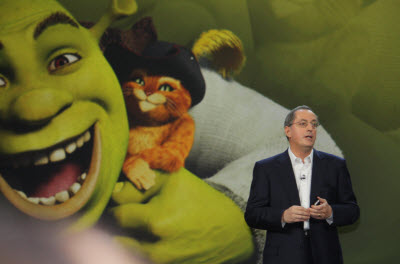
This afternoon, Paul Otellini, chief executive of Intel, followed suit, showing off a lot of 3-D demos in his keynote speech. They looked pretty slick, a lot like viewing movies in a big theater. But Otellini says that technology will filter into the mainstream, turning us all into 3-D videographers. (Which goes some way to answering the question we raised earlier today about what people are supposed to be watching on all the new 3-D displays about to hit the market.)
[aditude-amp id="flyingcarpet" targeting='{"env":"staging","page_type":"article","post_id":152460,"post_type":"story","post_chan":"none","tags":null,"ai":false,"category":"none","all_categories":"business,","session":"C"}']Otellini showed a scenario where a family could use a 3-D stereoscopic camcorder, which is basically two cameras tied together. After shooting a video, the family loads it onto their PC, then adds effects to make it look sharper when viewed with 3-D glasses. They can then convert the movies to be displayed on a TV set as well as share the video with friends on YouTube, who can watch it in 3-D.
To transfer a ton of 3-D video from one place to another, such as from a computer to a TV, takes a lot of bandwidth that current computers don’t have, even with the newly launched Universal Serial Bus Superspeed (USB 3.0). So Intel is working on Intel Light Peak, a next-generation data transfer technology that will transfer data at 100 gigabits a second. Current USB 3.0 can transfer data at 4 gigabits per second, or 10 times the theoretical speed of USB 2.0. The Light Peak technology is fast enough to transfer a Blu-ray movie in less than 30 seconds, Otellini said.
AI Weekly
The must-read newsletter for AI and Big Data industry written by Khari Johnson, Kyle Wiggers, and Seth Colaner.
Included with VentureBeat Insider and VentureBeat VIP memberships.
The 3-D wave is starting in a big way. Otellini said there were 20 3-D movies released in 2009 and 50 more would be released in 2010 (slightly different from what Jeffrey Katzenberg of DreamWorks Animation said — 10 movies in 2009). It takes a huge amount of processing power to render 3-D movies. Otellini said that it took more than 40 million rendering hours to make the fourth Shrek movie, which launches in May and is the first one in the series that is 3-D. That’s nine times the amount of computing hours it took to make the original Shrek movie in 2001.
Sports events such as the World Cup, special interest channels such as the Discovery Channel, and other shows being created in 3-D will bring the trend from the movies into the home, with 3-D TV. And at some point, perhaps sooner than you think, we’ll all be creating 3-D videos. (There are already 150,000 3-D clips on YouTube). At least that’s what Otellini says.
Check out our CES 2010 coverage here.
VentureBeat's mission is to be a digital town square for technical decision-makers to gain knowledge about transformative enterprise technology and transact. Learn More
